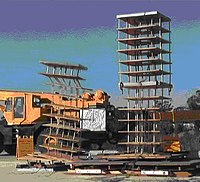
Photo from wikipedia
Vertical mass isolation (VMI) method is used for the seismic control of structures. In this method, the entire structure is considered to be a combination of two mass and stiffness… Click to show full abstract
Vertical mass isolation (VMI) method is used for the seismic control of structures. In this method, the entire structure is considered to be a combination of two mass and stiffness subsystems with an isolator layer located in-between. A magnetorheological (MR) damper is used as the isolator layer to control the structure. The semi-active control technique is applied to control the MR damper based on the applied controlling voltage. Several single degree of freedom structures with the same masses and main periods of 0.5, 1.0, 2.0 and 3.0 seconds are studied. Finally, a comparison between the results of this method with three passive control methods was performed. Results indicated that the semi-active control method based on maximum voltage of 9V will reduce, on average, the maximum roof displacement by 25% and 51% more than the Copt and passive-off methods and is equal to the passive-on method at 9V. However, the efficiency of the semi-active method in controlling the maximum absolute acceleration of the roof and the base shear of the structure was on average 28% and 45% lower than the Copt and passive-off methods, respectively and 2% higher than the passive-on method.
Journal Title: KSCE Journal of Civil Engineering
Year Published: 2020
Link to full text (if available)
Share on Social Media: Sign Up to like & get
recommendations!